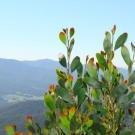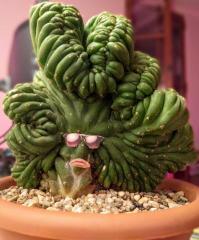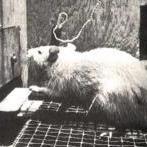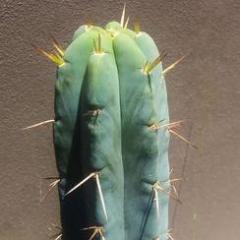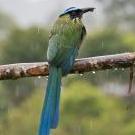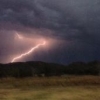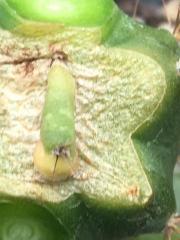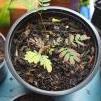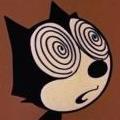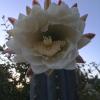Leaderboard
Popular Content
Showing content with the highest reputation on 18/03/18 in all areas
-
2 pointsI am no expert on Coleus however I feel as though my observations must be shared with this community. I have been reading of the use of the mysterious Coleus plant it seems, according to research and examination of 'trip reports', that eating/blending small leaves, smoking the leaves and sometimes producing a tea provides noticeable yet minimal effects in comparison to other psychedelic substances. However I came across one report on the Erowid Experience Vault where the user ate one large leaf described as a "leaf was about 6 inches long and 4-5 inches wide with lots of dark red on it", just before going to sleep. I will summarise his experience but if your are interested in this topic i recommend you to read the article https://erowid.org/experiences/exp.php?ID=56882 . His dream was set in the future and it involved violent aliens coming to Earth. He then advised his friend to try a large leaf before going to sleep (without telling his friend about his dream) and his friend reported to have the exact same dream. Here is where it gets interesting. ∂an reported about his use of Coleus (http://www.shaman-australis.com/forum/index.php?/topic/36752-using-plants-to-catalyse-dreams/#comment-441722) where he consumed some large leaves of the plant before going to bed. Very, very similar to the way the other user took Coleus. He too reported of violent aliens coming to Earth. Who knows if this was a coincidence or if this plant is hiding mystical secrets, however if the main active component of this plant is found and isolated its potential could be incredible. Look at Salvia Divinorum for example, it was thought to be 'placebo' and only have minimal effects however once the active compound Salvinorin A was found and extracts I don't think any people who have used the extract believe it only has minimal effects anymore . Just saying... it could have very high potential if studied more considering the freakishly similar dreams users who have eaten large, mature leaves before sleeping.
-
2 points
-
2 pointsHahaha Halycon are you trying to turn him into a neckbeard? Kindness the way I overcame it was being abstinent, make up your mind to not take your poison of choice and stick to it there is no other option, if it rears it's ugly head up to say hi 1. Tell it to fuck off. 2. Go throw some heavy metal objects around the room. 3. Move your body run, walk, get out into nature. 4. Go eat healthy fulfilling foods. 5. Be active keep your mind busy do whatever it takes. I used to think that I could take subsititutes for the addiction but your are still reinforcing the wiring to seek out substances, it didnt work, not until I made up my mind to not use ever again. Even years later through some low periods the craving still pops up to say hi, but is easily manageable and goes as quickly as it came on. This is the exact advice that I've recieved for 10 years and rejected it for that whole time, but it actually works.
-
2 pointsAbout the study Alchemica linked to (this one) suggesting "anti-depressant-like" effects, there are some real problems with their study design that you should consider before accepting their conclusions, especially these bits: In the first part, they seem to actually mean "anxiolytic" and just using "sedative" as a synonym, which it isn't. I can't even work out where the "muscle-relaxant" claim is coming from at all - unless it's mentioned in one of the other papers they reference - they seem to just be pulling that out of their arse. That they didn't make a quantitative analysis of their extract is also an issue, as it makes duplication difficult - they confirmed that cathinone was present, but we have no idea how much. But the major issue is the tests they've used to screen for "anti-depressant-like" activity, and their limitations: the forced-swim-test (FST), tail-suspension-test (TST) & hole-board-test (HBT). In the first two, the rodents are deliberately put into an uncomfortable/stressful situation, then the researchers time how long they keep struggling or trying to escape. The test ends when they stop moving, and that time is recorded. It is assumed that they stop moving because they've given up & lost hope of escaping. Leaving aside the problems of acute-vs-chronic-depression-models (which this article covers well: Doubt about antidepressant-like effect ), a big issue when using these tests for any kind of stimulant drug is that the rodents might keep moving around longer just because of the stimulant effects, and not because of any anti-depressant actions. This isn't to say these tests have no value, just that in the particular case of investigating stimulants (or depressants), they should be paired with other tests which take that into account, and try to separate the drugs effects on locomotor activity from its effects on mood. Given that this limitation was mentioned in the very first discussion of the TST in 1985, the fact that it's completely ignored in this 2017 paper (not only in their study design, which could be due to time/cost limitations, but also in their discussion/conclusion) is pretty inexcusable. Here's a few more recent papers which also discuss this problem & suggest some possible ways to account for it: Tail suspension test does not detect antidepressant-like properties of atypical antipsychotics Anti-immobility activity of different antidepressant drugs using the tail suspension test in normal or reserpinized mice - "Comparison of anti-immobility activities of putative anti-depressants in non-pre-treated and in reserpine-pre-treated mice, using the tail suspension test, may be useful to discriminate amphetamines from antidepressant drugs and to differentiate between categories of amine re-uptake blockers" Utility of ethological analysis to overcome locomotor confounds in elevated maze models of anxiety - "These results confirm that under certain test conditions, psychostimulants are capable of producing "false-positives" in elevated maze models, and that both traditional methods and the ethological measures used in this study fail to unequivocally dissociate drug effects on anxiety from effects on locomotor activity." (different test, but maybe applicable) And the other test used (which measures how much the animals will explore an unfamiliar environment, and assumes a link between this behaviour & anxiety levels) has similar limitations: Some doubts about the basic concept of hole-board test - "It is concluded, that the inverse relation between anxiety state and head-dipping activity is true only in a certain range of anxiety level. In more aversive situations, when the anxiety level of the animals is high, the holes nay represent a possible way to escape from the aversive environment instead of an explorable object." The exploratory behaviour of rats in the hole-board apparatus: Is head-dipping a valid measure of neophilia? - "Many unconditioned tests, such as the open field, potentially confound general locomotor activity with exploration. The hole-board apparatus appears to avoid this confound, as head-dipping into holes in the floor is assumed to be a valid measure of the subject's attraction towards novelty (neophilia).... Rather than being a measure of neophilia, these results support the hypothesis that head-dipping represents an escape response, which declines as the subject becomes less fearful." Summary version is that it seems more likely to me that the behaviour observed in that 2017 study could be attributed to khat's stimulant effects, rather than any anxiolytic/anti-depressant action.
-
2 pointsNice thread and gorgeous plants everyone! Here's what I got: - Pachanoi monstrose, sourced from Italia. Looks similar to the Altman clone? The guy sells PC labeled as such so it's likely: - Crested pachanoi, sourced from europe. Last pic is from last year, it grows fast: - Sausagy/caespitose/monstrose T. peruvianus, it literally pupped from every single areole on the bottom half or so: - Caespitose pachanoi or maybe peruvianus, some of the pups aren't normal pups as in they didn't emerge from an areole, but rather that areole started swelling and morphing into a pup, as seen in the middle of the last pic: - Pachanoi seedlings from Koehres seeds, seemingly doing some funky stuff. They'll be grafted soon: - If hybrids count, here are some. First I have this magnificent Oscar x Helen grown by PedroPark. I might soon cut one of the tiny pups off and graft it: - TPM x SS02 crest, a thing of beauty. Sourced from Spooge like all the following plants: - TPM x Pachanoi Monstrose: - TPM x Pachanoi: - TPQC x TPM crest:
-
1 pointI've been working on it for a while, maybe 10 years. It went unconditional today. I've finally bought a place with land, a home, a retreat, a track for the kids to ride their bikes, the forest next door but not close to the house, a huge shed, close to work, an outdoor area, humid and lush. For those of you who have done this before I tip my hat, it almost drove me nuts. It's a long path with many choices filled with pros and cons, sacrifices and benefits. Now I'm planning greenhouses and chicken coops, raised beds and natural fences.
-
1 pointhere mine, right now 4 different clones: 1. think it's the Altman/CCC/TPM1 of Sagi, from local supplier, he have very big crest plant, when i ask for cutting he bring me this plant 2. crest plant, i think it's TPM2 of sagi. 3.plant from the great Sagi sure it's tpm1 (am i right sagi?) 4. dunno what is it, nice monstrose, dosnt have any charters of knowen cutting. local grower 5. i think it's also TPM2 of sagi, from the same grower i get number 4. Sagi, what you thing? can you arrange my mind? Thanks :D
-
1 point
-
1 point
-
1 pointYeah, it's bloody hot today! Just went to check on a couple of my chacrunas outside, and they're completely floppy from the heat. Hopefully they don't lose any leaves
-
1 pointI looked on ebay i didn't know if that stem wrap the same as parafilm when i was looking i thought i read it was made of a different material. I did see some 1" stuff from china.
-
1 pointInyan, with so much flesh exposed, do you not hit with sulfur?
-
1 pointvery interesting, I didn't know about those experience reports on erowid where coleus was also found to catalyse other worldly dreams. my experience was with a majority green coleus with red colouration in the centre of the leaves, combined with caapi. I no longer have that coleus plant unfortunately. Christian Rätsch's book Encyclopaedia of Pyschoactive Plants has some interesting info in the entry for coleus blumei. Here is a summary: originally from SE asia, brought to south america post-conquest psychoactive use amongst the Mazatecs was discovered in 1962 in connection with Gordon Wasson's research into salvia divinorum [1] Mazatecs consider coleus to be in the same "family" as salvia, and has been reported to be used as a substitute for salvia (no reference given) however Daniel Seibert reported that he only ever met one person in the area of the Mazatecs who maintained that coleus was psychoactive [2] is used medicinally in Samoa, SE Asia and PNG to treat various maladies including digestive issues and headaches [1,3,4] Rosmarinic acid has been biosynthesised in cell cultures of coleus blumei [5,6] a diterpene (forskolin = coleonol) that is potently bioactive has been found in coleus forskohlii [4,7] salvinorin-like substances have been isolated from coleus blumei (no reference) 1. Ott 1993 2. Schuldes 1995 3. Uhe 1974 4. Valdes et al 1987 5. Häusler 1992 6. Meinhard 1993 7. D McKenna 1995 So it would appear that there are definitely some bio active compounds in some coleus plants, however its use as an effective shamanic intoxicant is inconclusive.
-
1 pointPostage: Doesn't post to Australia Try this https://www.ebay.com.au/itm/Paper-Parafilm-Florist-Floral-Tape-Wedding-Bouquet-Stem-Wrap-Craft-Waterproof/302559987943?hash=item4671fb08e7:m:miPEV5ojVZcRFOG6k7aUYPA
-
1 pointNext joke Ive not once been to Sydney and it's been a warm or even sunny day haha always pissing down
-
1 pointAny 1 know of a parafilm source in aus that's reasonably priced?
-
1 pointWell, if you guys can manage in northern europe and zone 8 USA, then it looks like I'll be fine here in warm sunny Sydney Thanks
-
1 pointLove to see the grafts Gimli. Keep em coming. Some of my grafts today...
-
1 pointYeah hiting on Australia then Australia underneath doesn't seem to quote postage the next button is confirm order with no idea how much shipping is? keen on some willie seeds if there sent coded?
-
1 pointMaccas providing the goods once again Just had a look at the Erowid Experience Vaults and no one has reported using the coleus with Syrian Rue, would be interesting to see if how the Harmala alkaloids of the Syrian Rue combine with the unknown active components of the Coleus...
-
1 pointIt was the same plant i posted a picture of. No idea what strain it is i stole a cutting from outside Maccas. Theres some coleus blumei in my area too so i'll give that a try. Dark red almost brown seems about right. The amount of light they get really effects it. I wonder if Syrian rue would have any effect on the results
-
1 pointSee how the flowers in the first pic aren't hairy (covered in trichomes) that's how you know it isn't a Trichocereus which basically means 'hairy cactus' (referring to the flowers). The thin-ish ribs will also tell you that it's a Cereus, a nice short-spine one.
-
1 pointThis graft was done on July 28. And for all of Aug and most of Sep...nothing. Then in the last week, signs of life! I don't have very much experience grafting, but is this normal?
-
1 pointAnd California Cactus Center's (CCC) T. peruvianus (which became T. peruvianus short spine as discussed on page 1.) This ones as tall as me. The crest is just a few years old.
-
1 point

